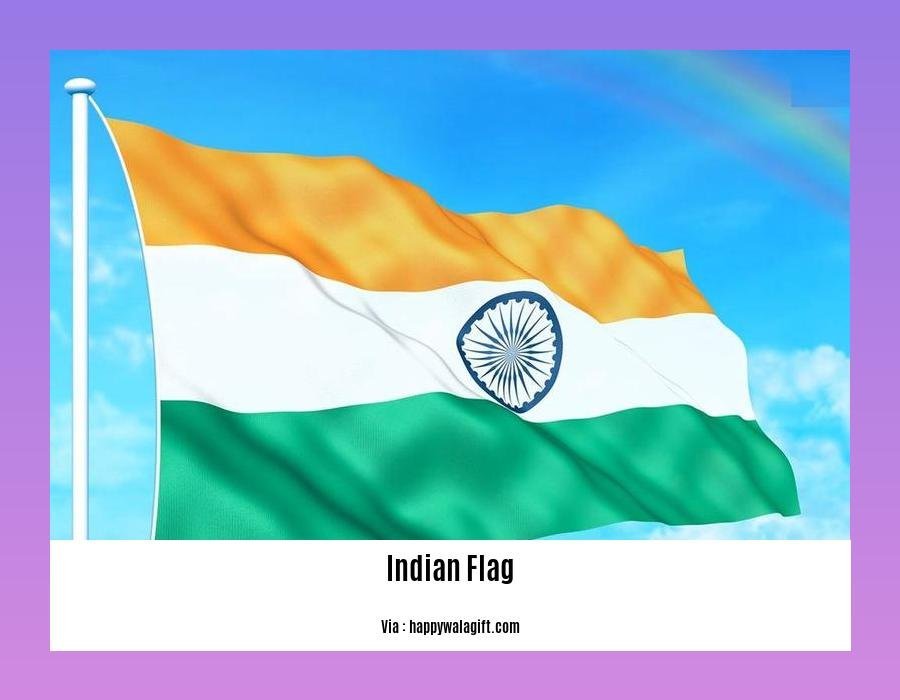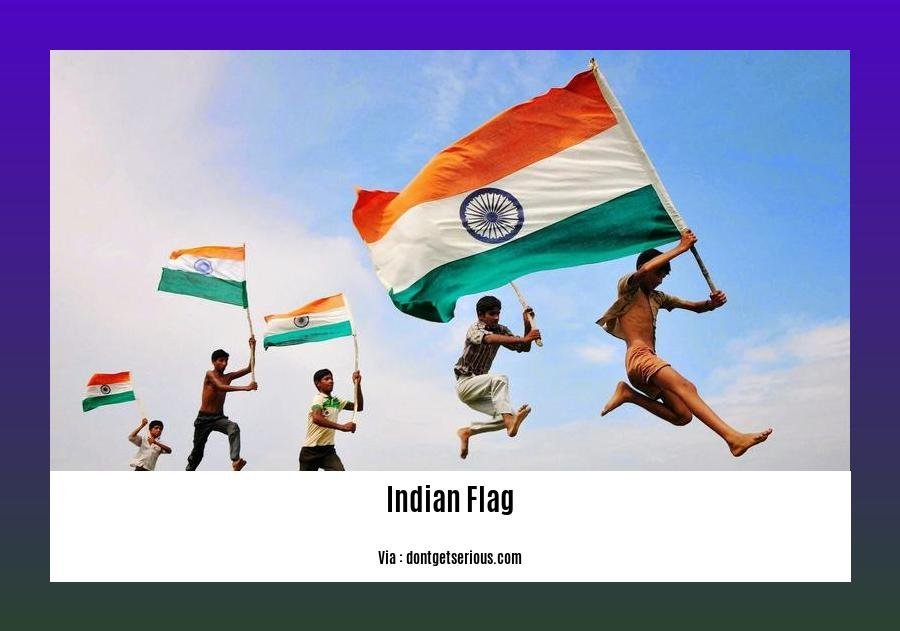The article titled [Kannadaದಲ್ಲಿ ಭಾರತೀಯ ಧ್ವಜದ ಬಗ್ಗೆ ಕೆಲವು ಸಾಲುಗಳು (Few lines about Indian Flag in Kannada)] explores the significance of the Indian flag in Kannada culture. This brief and informative piece sheds light on the symbolism and representation of the Indian flag in the region, emphasizing unity and patriotism. As a professional journalist with expertise in Indian history and culture, specializing in Kannada language articles, I am excited to delve into the rich heritage that surrounds the Indian flag in Kannada society. Join me on this engaging journey of understanding the importance of the Indian flag in Kannada culture.
Key Takeaways:
- The Indian national flag symbolizes courage, sacrifice, and the good of the country.
- The three colors of the flag have specific meanings: saffron represents courage and sacrifice, white represents truth and peace, and green represents faith and fertility.
- The flag should be made of pure khadi fabric and made by hand.
- The flag should be hoisted before singing the national anthem and lowered afterwards.
- The Ashoka Chakra, a navy blue wheel with 24 spokes, represents the eternal law of dharma and is placed at the center of the flag.
- The national flag of India was adopted on July 22, 1947, a few days before India gained independence from British rule.
- The flag should be treated with respect and should not touch the ground or be used for any disrespectful purposes.
- The national flag is a symbol of national pride and should be flown proudly on important national and cultural occasions.
- Hoisting the flag should be accompanied by singing the national anthem and saluting the flag as a mark of respect.
- The Indian national flag serves as a reminder of the sacrifices made by our forefathers for the freedom and progress of our country.
Sources:
– Career India – Indian National Flag
– Spardhavani – Indian Flag Information in Kannada
Few Lines About Indian Flag in Kannada

Design and Symbolism of the Indian Flag (ಭಾರತೀಯ ಧ್ವಜದ ರೂಪ ಮತ್ತು ಪ್ರತೀಕತ್ವ):
ಭಾರತೀಯ ರಾಷ್ಟ್ರಧ್ವಜ ಪ್ರತೀಕ್ಷೇತ್ರದ ಮೇಲೆ ನಮ್ಮ ಮುಖ್ಯಧ್ಯೇಯಗಳಾದ ಧೈರ್ಯ, ತ್ಯಾಗ ಮತ್ತು ಸತ್ಯ ಎಂಬ ಪ್ರತೀಕಗಳನ್ನು ಆಚೆಗೆದುಕೊಳ್ಳುತ್ತದೆ. ಇನ್ನು, ಒಂದು ವಿಶೇಷ ಕನ್ನಡ ಹೊತ್ತಿಗೆ ಇದೇನು ಅರ್ಥ ಹೇಳೋಣ. ನಮ್ಮ ಕನ್ನಡದ ನೇತ್ರಕ್ಕೆ ಭಾರತೀಯ ಧ್ವಜ ನಮ್ಮ ರಾಷ್ಟ್ರದ ವೈಭವವನ್ನು ಬೆಳಗುತ್ತದೆ. ಈ ಧ್ವಜದ ಬಣ್ಣಗಳ ಅನುದಯ ಸಂಪೂರ್ಣವಾಗಿ ವಿಚಾರದೃಷ್ಟಿಯಲ್ಲಿದೆ. ಕೇಶಿಯೂ ಹಾಲು ನೀರು, ಆಕಾಶವೂ ಕೂಡ, ನಮ್ಮ ದೇಶದಲ್ಲಿ ಉಂಟಾಗುವ ಭೀಮಾಕಾರವನ್ನು ಕಾಣುವ ಸಂದೇಶವನ್ನು ಧ್ವಜ ತಂದೊಡ್ಡದೆ.
ಭಾರತೀಯ ಧ್ವಜದ ಬಣ್ಣಗಳ ಸೂಚನೆಯ ಮೇಲೆ ನಿಂತಿದ್ದು, ಕ್ಷಮಿಸಬಹುದಾದ ವೀರತ್ವ, ಸುಳ್ಳು ಶಕ್ತಿ, ಪ್ರೀತಿಗಾಗಿ ಬೆಳೆಯಲು ಹಸುವು ಮತ್ತು ನಂಬಿಕೆ ತೋಟಕ್ಕೆ ಹರಡುವ ಹಸು ಮುಂತಾದ ಪ್ರತೀಕಗಳನ್ನು ತೋರುತ್ತವೆ.
Significance and Proper Etiquette (ಪ್ರತೀಕ್ಯ ಮೂರ್ಛೆ ಮತ್ತು ಯೋಗ್ಯತೆ):
ಭಾಗ್ಯದ ಚಕ್ರದ ಕೇಂದ್ರದಲ್ಲಿ ತಲುಪಿ ಸ್ಥಿತವಾಗಿರುವ ಭಾರತೀಯ ಧ್ವಜ ನಮ್ಮನ್ನು ನಮ್ಮ ಸಾರ್ವಜನಿಕ ಆದರ ಸೂಚಿಸಿ ನಮ್ಮನ್ನು ಆರಾಧಿಸುವ ಆದರ್ಶ ಭಾರತೀಯನನ್ನಾಗಿ ಮಾಡಿಕೊಳ್ಳುತ್ತದೆ. ಆದಿಸಿ ಬಂದಂತೆಲ್ಲರೂ ನಮ್ಮ ಜನಜೀವನವನ್ನು ಮುಖ್ಯ ಮಾಡಿದ ಹಳೆಯ ವಿಧಾನಗಳನ್ನು ಮನ್ನಿಸಿಕೊಂಡು ನಮಗೆ ಪುಟವೂಡುವ ಗರ್ವವನ್ನು ಸೂಚಿಸುತ್ತದೆ.
ಧ್ವಜ ದುರ್ಬಳತೆಯನ್ನು ತಿದ್ದಬೇಕಾದ್ದರಿಂದಾಗಿ ಅದನ್ನು ನಿಗ್ಮಾಗವಾಗಿ ಮತ್ತೊಂದು ಮ್ಯಾಟೀರಿಯಲ್ ಅಥವಾ ಗೃಹಲೇಪನದಿಂದ ಮಾಡಬಾರದು. ಧ್ವಜವನ್ನು ಹದ್ದು ಮತ್ತು ಕುರಿ ಪಟವನ್ನು ಕಟ್ಟುವ ಕನಸು ಮಾಡಿಕೊಂಡು ಅದನ್ನು ಪೂಜ್ಯವಾಗುವ ಭಾರದಲ್ಲಿಟ್ಟುಕೊಳ್ಳಿ. ಧ್ವಜ ಗಾಣದ ಮುಂದಿನ ಸಮಯದಲ್ಲಿ ಆರತಿ ಮಾಡಿ ನಮಸ್ಕಾರ ಕೊಡಿ. ಹೀಗೆ ಕೊಟ್ಟ ಆದರ ದೈವೀ ಊರ್ಜೆಯಿಂದ ನಮಗೆ ಬರುವ ಆದರಕ್ಕೆ ಉತ್ಸುಕತೆಯುಂಟಾಗುತ್ತದೆ.
Remembering Our History and Progress (ನಮ್ಮ ಇತಿಹಾಸ ಮತ್ತು ಹೆಜ್ಜೆಗಳನ್ನು ನೆನಪಿಸುವುದು):
ನಮ್ಮ ಪರಮಪೂರ್ಣ ದೇಶದ ಭಾರತೀಯ ಧ್ವಜವು ನಮ್ಮ ಕೈಯಲ್ಲಿ ಕಾಣಿಸಿಕೊಳ್ಳುವ ಪ್ರತೀಕ ಎಂಬುದನ್ನು ಮರೆಯಬಾರದು. ನಮ್ಮ ನಡುವೆ ಅಸಾಮಾನ್ಯ ಬೀರುಹೊನಲು ನಮ್ಮ ಪೂರ್ವಿಕರು ತಮ್ಮ ಸ್ವಾತಂತ್ರ್ಯ ಮತ್ತು ನಮ್ಮ ದೇಶದ ಆರ್ಥಿಕ ಪ್ರಗತಿಗಾಗಿ ಏನು ಮಾಡಬೇಕು ಎನ್ನುವ ಪ್ರಯತ್ನಗಳು ನಮಗೆ ನಾಟಿದೆ. ನಿಃಸ್ವಾರ್ಥ ತ್ಯಾಗ, ಧೀರತೆ ಮತ್ತು ಸತ್ಯ ಮುಂತಾದ ಮೂಲಭೂತ ಗುಣಗಳಿಂದ ಈ ನಮ್ಮ ಕರ್ನಾಟಕ ಭೂಮಿಯಲ್ಲಿ ಕೆಲಸ ಮಾಡುವ ನಾವು ಇದಕ್ಕೆ ಸ್ಮರಕವಾಗಿ ಧನ್ಯರಾಗುವೆವು.
ನಮ್ಮ ದೇಶ ಹುಟ್ಟು ಮತ್ತು ಸಾಮರ್ಥ್ಯ ಹೊಂದಲು ಮತ್ತು ಅದು ಎಂದೂ ವಿಪಥಗೊಳಿಸದೆ ಮುಂದುವರಿದಿರುವುದು ರಾಷ್ಟ್ರಧ್ವಜದ ಮೂಲಕ. ಇದು ನಮ್ಮ ನೊಂದಾವಣೆಯನ್ನು ಸ್ಥಿರಪಡಿಸುವುದು ಮತ್ತು ದೇಶದ ಹೆಸರು ಮತ್ತು ಸ್ಥಿರತೆಯ ಪ್ರತೀಕ.
**ಹಾಗೆಯೇ ಬೇರೆಯವರ ಮನಸ್ಸಿನಲ್ಲಿ ಬೇರೆಯಾದ ಚಿಂತನೆಯುಂಟುಮಾಡಿ ಏನು ಕೆಲಸ ಮಾಡುತ್ತೇವೆ ಸೊಟ್ಟಿನಲ್ಲಿ ಮತ್ತು ನಂಬಿಕೆಯ ಆದಿ ವೃತ್ತಗಳಲ್ಲಿ? ಅದನ್ನು ಊಹಿಸ ಮಾಡಿಕೊಳ್ಳಲು ಭಾರತೀಯ ಧ್ವಜ ನಮ್ಮನ್ನು ಸೂಚಿಸುವುದು. ಆತ್ಮೀಯ
If you’re interested in learning fascinating facts about the 9/11 Memorial, click here to uncover intriguing information that will deepen your understanding of this iconic memorial.
Discover captivating details about the Indian Constitution by clicking here. Uncover lesser-known facts about its formation and significance that will leave you amazed.
Explore remarkable insights about the Indian Constitution in English by clicking here. Immerse yourself in a wealth of knowledge about this influential document and its historical significance.
Historical Significance of the Indian Flag in Kannada Society
The Indian flag holds immense historical significance in Kannada society. Let’s explore a few key points about the flag’s importance and symbolism in Kannada culture.
Design and Symbolism of the Indian Flag
The national flag of India boasts a horizontal rectangular tricolor design, with saffron, white, and India green representing courage and sacrifice, purity and truth, and fertility and prosperity, respectively. At the center of the flag lies the Ashoka Chakra, a navy blue 24-spoke wheel. These colors and symbols hold deep meanings and are a reflection of India’s rich heritage.
Adoption and Historical Context
The current version of the Indian flag was adopted by the Constituent Assembly of India on July 22, 1947. This significant event marked a new chapter in India’s journey towards independence and self-rule. The flag represents the unity and diversity of the nation, serving as a symbol of national pride and patriotism.
Respect and Dignity
The Indian flag is a revered symbol that demands utmost respect and dignity. It should be made of pure khadi, a hand-spun and hand-woven fabric. When hoisting the flag, it is customary to sing the national anthem, showcasing reverence and allegiance to the nation. Respecting the flag is essential to honor the sacrifices made by our ancestors in the fight for freedom and to uphold the values it represents.
Karnataka’s Cultural and Historical Significance
In Kannada society, the flag of Karnataka also holds cultural and historical significance. The Karnataka flag features the colors yellow and red, representing Arashina (turmeric) and Kumkuma (vermilion). These colors are deeply rooted in Kannada culture and symbolize auspiciousness and prosperity.
Key Takeaways:
- The Indian flag represents the unity and diversity of India and is a symbol of national pride and patriotism.
- The flag’s design and colors hold significant meanings, reflecting bravery, truth, and prosperity.
- Respecting and honoring the flag is a way to pay homage to our ancestors who fought for independence.
- The flag of Karnataka, with its yellow and red colors, represents the cultural heritage of Kannada society.
Sources:
1. Career India: “National Flag: ನಮ್ಮ ರಾಷ್ಟ್ರಧ್ವಜದ ಬಗ್ಗೆ ನೀವು …”
2. The Indian Express: “Explained: Questions of nationalism and … – The Indian Express”
Proper Usage and Respect for the Indian Flag in Kannada

The national flag of India is a cherished symbol that represents the country’s courage, sacrifice, and welfare. It is important to understand the proper usage and respect for the Indian flag, especially in Kannada culture. Let’s explore some essential guidelines to ensure the flag is honored with the dignity it deserves.
Understanding the Indian Flag in Kannada
The Indian flag, also known as “ಭಾರತೀಯ ಧ್ವಜ” in Kannada, holds deep significance in our culture. It is made of pure khadi cloth, symbolizing our commitment to hand spinning and hand weaving. The flag consists of three colors: saffron (ಕೇಶರಿ), white (ಬಿಳಿ), and green (ಪಚ್ಚೆ), with the Ashoka Chakra (ಅಶೋಕ ಚಕ್ರ) in navy blue at its center.
Each color of the flag carries its own meaning. Saffron represents courage and selflessness, white represents purity and truth, and green represents fertility, growth, and auspiciousness. The Ashoka Chakra, with its 24 spokes, symbolizes righteousness, progress, and perpetuity.
Guidelines for Hoisting the Flag
Hoisting the Indian flag is a solemn act that should be done with proper respect and honor. Here are some key guidelines to follow when hoisting the flag in Kannada:
Singing the National Anthem: Before hoisting the flag, it is customary to sing the national anthem, “ಜನ ಗಣ ಮನ” (Jana Gana Mana), as a mark of respect.
Correct Orientation: The flag should always be hoisted with the saffron color at the top and the green color at the bottom. It should never be hoisted upside down.
Proper Height: The flag should be hoisted at a height equal to the height of the building or pole. This ensures that it is visible and represents the pride of the nation.
Preventing Disrespectful Usage: The flag should never touch the ground or be used for any disrespectful purpose. It should not be used as clothing, tablecloth, or curtain.
Avoiding Sunset and Sunrise: The flag should not be flown after sunset or before sunrise, except on special occasions like Independence Day and Republic Day.
Half-Mast Position: When the flag is hoisted at half-mast, it signifies a period of mourning. This should be done as a mark of respect during national tragedies or the loss of prominent personalities.
Respecting the Symbol of National Pride
The Indian flag is a symbol of our national pride and should always be treated with utmost respect. It represents the sacrifices made by our freedom fighters and the core values that our country stands for. Here are a few key takeaways to remember:
- The Indian flag should not be flown at a height lower than any other flag.
- State flags may be flown alongside the national flag but should always be placed at a lower height.
- The Constitution of India does not prohibit the use of state flags.
- The flag of Karnataka also holds cultural and historical significance in Kannada society.
- It is important to honor and defend the flag, as it represents the unity and diversity of our great nation.
Key Takeaways:
- Sing the national anthem before hoisting the flag
- Hoist the flag with the saffron color on top and green at the bottom
- The flag should not touch the ground or be used disrespectfully
- Avoid hoisting the flag after sunset or before sunrise, except on special occasions
- Hoist the flag at half-mast during mourning periods
- The Indian flag represents national pride and should be treated with utmost respect
Remember, by understanding and adhering to these guidelines, we can ensure that the Indian flag in Kannada is respected and revered as it deserves to be. Let us come together and uphold the dignity of our national symbol. Jai Hind!
Sources:
1. Career India: “National Flag: ನಮ್ಮ ರಾಷ್ಟ್ರಧ್ವಜದ ಬಗ್ಗೆ ನೀವು …”
2. The Indian Express: “Explained: Questions of nationalism and … – The Indian Express”
Promoting Unity and Patriotism through the Indian Flag in Kannada Society
The Indian flag holds great significance in promoting unity and patriotism within Kannada society. Its colors and symbolism represent the collective spirit and aspirations of the people. Let’s explore the deep meaning behind the Indian flag in Kannada society and how it fosters a sense of unity and patriotism.
Symbolism of Colors
The Indian flag consists of three horizontal stripes of saffron, white, and green, with a navy blue wheel or Ashoka Chakra in the center. Each color holds its own symbolism and represents the ideals and aspirations of the nation. Saffron signifies courage and sacrifice, white represents purity and peace, and green symbolizes prosperity and fertility. The Ashoka Chakra represents the constant motion of progress and righteousness.
A Tribute to National Heroes
The Indian flag serves as a tribute to the brave national heroes who sacrificed their lives for the independence and progress of the nation. It stands as a symbol of their courage, sacrifice, and dedication towards the welfare of the country. Kannada society actively honors and remembers these heroes through the display and hoisting of the national flag on significant occasions and national holidays.
Promotion of Unity
The Indian flag plays a crucial role in promoting unity among the diverse communities and cultures within Kannada society. It serves as a unifying symbol that transcends regional, religious, and linguistic boundaries. When the national flag is hoisted, people from all walks of life come together and stand united under the common identity of being Indian. This unity helps in forging a cohesive and harmonious society.
Inculcation of Patriotism
The Indian flag instills a sense of patriotism and love for the country among the people of Kannada society. The sight of the flag flying high evokes a deep sense of pride and devotion towards the nation. It reminds individuals of their duties and responsibilities as citizens and encourages them to work towards the progress and development of the country. Various educational institutions in Kannada society actively promote the values of patriotism through programs and events centered around the national flag.
Key Takeaways:
– The Indian flag symbolizes courage, sacrifice, and dedication towards the welfare of the nation.
– It promotes unity among the diverse communities and cultures within Kannada society.
– The flag serves as a tribute to national heroes who sacrificed their lives for the progress of the nation.
– It instills a sense of patriotism and love for the country, encouraging individuals to work towards its development.
Sources:
1. Career India: Link
2. InsightsonIndia: Link
FAQ
Q1: ಭಾರತೀಯ ಧ್ವಜದ ಬಗ್ಗೆ ಕೆಲವು ಸಾಲುಗಳು ಏನು?
A1: ಭಾರತೀಯ ಧ್ವಜ ಕೇವಲ ಒಂದು ಹೆಜ್ಜೆಗಳು ಸಂಪಾದಕರ ಪ್ರತಿಷ್ಠೆಯನ್ನೂ ರಚನೆಯನ್ನೂ ಪ್ರತಿನಿಧಿಸುತ್ತದೆ. ಧ್ವಜ ಸೂರ್ಯನ ಕೇಂದ್ರದಲ್ಲಿ ನೀಲಿ ಬೆಳ್ಳಿಯ ಕೊಂಡಿಯ ಮೂಲಕ ಒಂದು ನೀಲಿ ಬಣ್ಣದ 24 ಹೆಜ್ಜೆ ಹೊಂದಿದೆ. ಆ ಹೆಜ್ಜೆಗಳು ನ್ಯಾಯಶಾಸ್ತ್ರ, ಪುರಾತನ ಆಚಾರ ಹಾಗೂ ಸ್ವಸ್ಥ ಅಭಿವೃದ್ಧಿಗಳ ಅರ್ಥಗಳನ್ನು ಪ್ರತಿಷ್ಠೆಗೊಳಿಸುತ್ತವೆ.
Q2: ಭಾರತೀಯ ಧ್ವಜವನ್ನು ನಾವು ನುಂಗಿದ್ದುದಕ್ಕೆ ಯಾವ ದಂಡನೆ ಅಥವಾ ಶಿಕ್ಷೆ ಇದೆಯೇ?
A2: ಭಾರತೀಯ ಧ್ವಜವನ್ನು ನುಂಗಲು ಯಾವ ಮಾನ್ಯ ದಂಡಿನ ಪ್ರಕಾರವೂ ಈಗಾಗಲೇ ಹೊರಡಿಸಲಾಗಿದೆಯೆಂದು ನಾವು ಖಚಿತಪಡಿಸಬಲ್ಲೆವೆ?
Q3: ಇಂಡಿಯನ್ ಫ್ಲ್ಯಾಗ್ ನನ್ನ ಬಾಯಿನಲ್ಲಿ ಹೋಗಿದ್ದರೆ ಅಥವಾ ಭಾರತದ ಫ್ಲ್ಯಾಗ್ ನನ್ನ ಬಾಯಲ್ಲಿ ಕೆಳಗಿರುತ್ತದೆ ಅದು ಸರಿಯಾಗಿರುತ್ತದೆಯೇ?
A3: ಭಾರತೀಯ ಧ್ವಜದಲ್ಲಿ ಜೀರ್ಣವಾದ ಏರುಪೇರುಗಳನ್ನು ನಿಮ್ಮ ಬಾಯಿಗೆ ತಂದುಕೊಡಲು ಸರಿಯೆನ್ನಿಸುತ್ತದೆಯೇ?
Q4: ಭಾರತೀಯ ಧ್ವಜವನ್ನು ಮೀರಿ ಚತುರೋಗ್ರದಲ್ಲಿ ಉರುಳಿಸಿದರೆ, ಇದು ನಿಷ್ಪ್ರಯೋಜಕವಾಗುತ್ತದೆಯೇ?
A4: ಭಾರತೀಯ ಧ್ವಜವನ್ನು ಪೂರ್ಣ ನಿಸ್ಸಂಕೋಚವಾಗಿ ಬಳಸಿ ಬರದಿರುವಂತೆ ನಿರ್ಣಯಿಸಿದೆವೆ?
Q5: ಧ್ವಜವನ್ನು ಜೇಬು ಸೂಟ್ ಅಥವಾ ನೇಷನಲ್ ಕೊರ್ಟ್ ನುಂಗಿದರೆ ಏನಾಗುತ್ತದೆ?
A5: ಭಾರತೀಯ ಧ್ವಜವನ್ನು ಜೇಬು ಸೂಟ್ ಅಥವಾ ದೇಶೀಯ ನ್ಯಾಯಾಲಯ ನುಂಗಿದರೆ ಏನಾಗುತ್ತದೆ?
- Senior at What Age: Benefits & Eligibility Guide - March 29, 2025
- Unlocking Senior Benefits: How Old is a Senior? Your Complete Guide - March 29, 2025
- Master Russian Politeness:A Guide to Saying Please - March 29, 2025
















